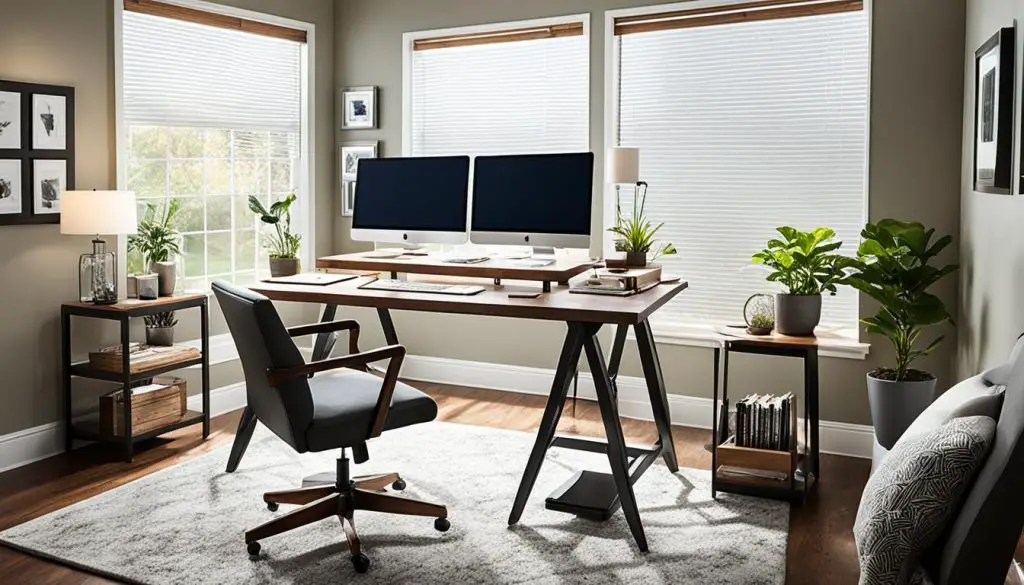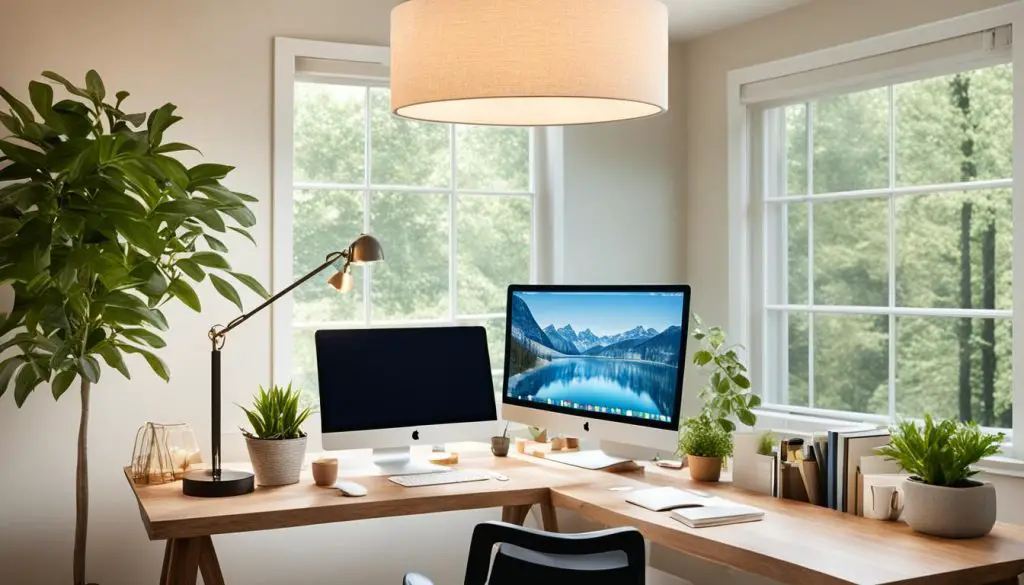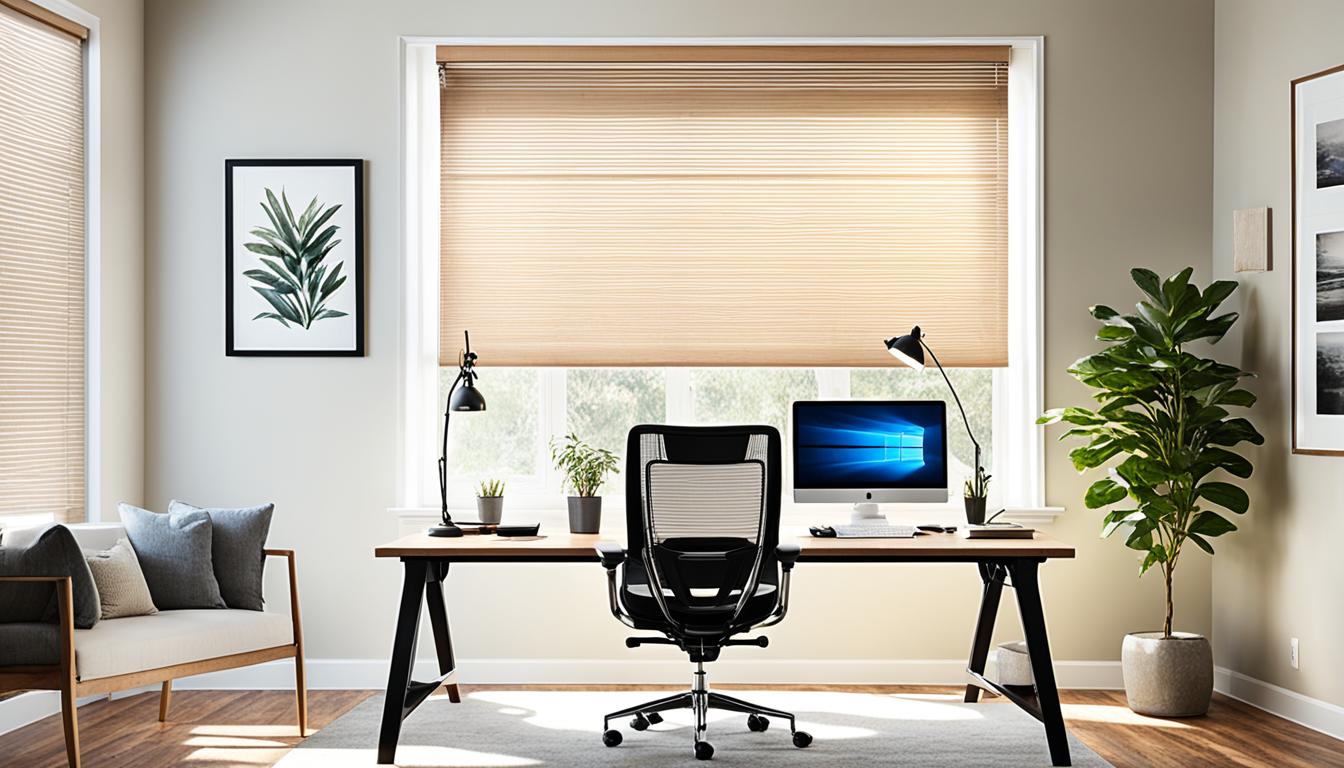Living with a chronic illness like my wife’s endometriosis and fibromyalgia has shown me how important a good home office is. Lighting, meant to brighten our workspace, might actually make symptoms worse. So, what are the best lighting options for those of us who work from home with chronic conditions? This guide looks at the top choices, including LED options for managing chronic pain and energy-efficient lights for fighting fatigue.
It also covers how to manage blue light, improve your natural sleep cycle, and create a lighting setup that’s right for you. By the end, you’ll know exactly what lighting is best for your chronic illness home office.1
Importance of Proper Lighting for Chronic Illness
For people with chronic illnesses, having the right lighting at work is crucial.2 Many suffer from light sensitivity and photophobia, which can make working hard. Research shows 9 out of 10 employees struggle to work well when light bothers them. This leads to less focus, reduced productivity, and the need for more breaks.2
Impact of Light Sensitivity on Work Performance
Bad lighting at work can cause the “sick building syndrome.” This brings symptoms like tiredness and headaches.2 If you’re already dealing with a chronic illness, these effects can be worse. So, it’s important to meet the lighting needs of those sensitive to light. This helps make the work space better for them.
Challenges Faced by Light-Sensitive Employees
People with light sensitivity and photophobia find work harder. They might struggle to concentrate under bright lights or get bad migraines from glare. These issues can seriously impact how well they do their job, how happy they are with it, and their general health.
Understanding Light Sensitivity and Photophobia
Light sensitivity is often called photophobia. It happens when bright lights make you uncomfortable or can even cause pain. This can lead to headaches, dizziness, and feeling sick. Many health conditions, like migraines, traumatic brain injury, and certain eye or brain issues, can make you sensitive to light.3
Causes and Symptoms of Light Sensitivity
There are many reasons why you might be sensitive to light. It could be due to problems in the back of your eye or in the brain’s visual center. Light sensitivity can cause anything from a minor bother to real pain. You might get headaches, feel like your eyes are working too hard, see less clearly, or even become nauseous or dizzy.3 Knowing what’s behind your light sensitivity and how to handle it is key.
Conditions Associated with Light Sensitivity
Light sensitivity often shows in various chronic health problems, like migraines, brain injuries, and eye or brain troubles. A good example is how bright lights or certain light types can worsen migraines. This is a major issue for many people, affecting their daily life.
If you’ve had a head injury or concussion, you might keep feeling sensitive to light. This light sensitivity is a common symptom after such events.3 It’s important to link your light sensitivity to the right health condition to find the best ways to manage it.
Reasonable Accommodations for Light-Sensitive Employees
Employers should know the difficulties light-sensitive workers face. They must learn about and provide necessary supports. The American with Disabilities Act (ADA) says employers must help employees with disabilities like light sensitivity.4
Alternative Lighting Options
One helpful change is offering different lighting. This can mean making lights less bright, using dimmers, or adding desk lamps. These choices aim to cut down on glare.4 Employers might also add anti-glare screens on computers or adjust natural light with special window covers.4
Flexible Work Arrangements
Working from home is a big help for some light-sensitive workers. It lets them control their light environment better.4 Another option is flexible hours. This way, employees can avoid bright lights during their commute.4
Assistive Technologies and Ergonomic Solutions
Technologies can also assist these employees. Adjustable desk lamps and screen filters can lessen light sensitivity impacts.4 Teaching about tools like blue light blocking glasses can also empower and educate workers.4
By providing needed supports, the workplace becomes more welcoming and productive. Job satisfaction and well-being also go up for all.354
Best Lighting Chronic Illness Home Office
Setting up a home office for those with chronic illness means choosing the right lights is crucial.6 LED lights are a top pick. They emit less heat than other types and you can adjust them. This is great because it means you can have the right light without making pain worse.
LED Lights for Chronic Pain
LED lights are awesome for fighting chronic pain in your home office.6 They don’t get as hot as older light types, which is key for reducing discomfort. Plus, you can tweak the brightness and the warmth of the light. This makes it perfect for your unique needs, boosting how comfy and useful your workspace is.
Energy-Efficient Home Office Lighting
An energy-saving home office is good for your wallet and your health.6 LEDs stand out for their low energy use – they may cut your bill by 75% compared to old bulbs. This savings can lighten the load for people with chronic illnesses, who often have more expenses to worry about.
Task Lighting for Fatigue
The right task lighting can cut down on fatigue in your chronic illness home office.6 Placing and adjusting your lights well can lower eye strain, headaches, and the tiredness that slows you down. This lets you work better and feel better despite your health issues.
| Lighting Feature | Benefit for Chronic Illness Home Office |
|---|---|
| LED Lights | Reduced heat emission, adjustable brightness and color temperature to manage chronic pain6 |
| Energy-Efficient Design | Lower energy consumption and cost savings for those with higher healthcare and living expenses6 |
| Task Lighting | Minimizes eye strain, headaches, and fatigue to support productivity and comfort6 |
Circadian Rhythm Lighting
Living with a chronic illness has shown me how vital circadian rhythm lighting is for overall health. Updating my home office lights helped me sync with natural day-night cycles. It regulated my sleep, boosted mood, and helped think better.7
By changing light colors and brightness through the day, I tweaked my circadian rhythm. This made my body clock work better with my job hours. The result? I work more efficiently and feel awake all day long.7
Adding circadian rhythm lighting to my home office changed everything. I sleep better now and feel more in control of my health. Light use is key to staying balanced and healthy while at home.7

Blue Light Filters
I live with a chronic illness, so I know how important managing blue light is. This light comes from digital screens we use every day. It can make light sensitivity worse and cause eye strain, headaches, and other problems.8 Using blue light filters – like screen protectors or special glasses – has really helped. It makes my work space more comfortable and supports me better.
Screen Filters and Protective Eyewear
Using screen filters or protective eyewear is a great way to fight back against blue light. Studies show these tools can lower eye strain and make our vision more comfortable, especially for people like me with health issues.8 With a screen protector on my laptop or blue-light-blocking glasses, I see a big difference every day. It helps me work better and feel healthier.
Adding these filters to my home office has really changed things. It’s now a more caring place for me, considering my health. With less eye strain and fewer headaches, I can concentrate longer. This has improved how well I work and my life in general.8
Ergonomic Lighting Solutions
I’m a chronic illness patient. It’s vital for me to use ergonomic designs in my home office lighting.9 This setup, like where I put my desk, computer, and lights, can lessen my eye strain and headaches.9 Using an ergonomic approach to lighting makes my work space better. It meets my special needs well.
Proper Workstation Setup
Getting my workspace right is key. My desk, computer, and light sources must be set up just for me.9 I think about the height and spots for my desk, where I place my screen, and the best lighting. This careful arrangement helps me avoid eye strain and glare. It also helps me sit better, which means I work better and feel less tired.9
Adjustable Lighting Options
Changing my lighting how I need is a big help.9 Living with a chronic illness means my lighting needs can change. Sometimes, I need different lights for different tasks.9 Using lights that can adjust, like lamps that dim or smart systems, lets me set up the perfect light. This way, I’m more comfortable and productive.
Comfortable Illumination
Finding the right light for a home office is crucial for those with chronic illnesses. It’s important to choose the correct fixtures and bulbs. Also, we need to cut down on glare and harsh lighting that worsens symptoms.10
Reducing Glare and Harsh Lighting
Too much sunlight can create glare, which distracts us. It underscores the need for choosing the right bulbs and shades.10 Darker colors absorb light, which can make the room feel more comfortable. Placing your desk away from direct light helps too.10 Using task lights helps you work better, even if it’s cloudy outside.10
For small desk areas, consider using LED strips or clamping lights.10 Gantri makes eco-friendly lights that look great and help create a better workspace.10 A well-lit and glare-free office means you can work better and enjoy it more.10
Light Therapy Lamps
I use light therapy lamps in my home office due to my chronic illness. These lamps give off 10,000 lux of white light, which helps with [Light Therapy], boosting my [Mood Improvement] and energy. They don’t have any harmful UV rays, making them safe to use.
Bright light therapy is as effective as drug treatments for non-seasonal depression. It’s a great option for people battling [Seasonal Affective Disorder] and other mood issues.11 Doctors suggest using the light for 30 minutes in the morning. I’ve seen better moods and energy within one to two weeks of starting this routine.11
But, if you have bipolar disorder, it’s best to talk to your doctor first. Light therapy might affect your condition.11 There are many cost-effective choices out there. For instance, you can find the HappyLight Alba by Verilux for $49.99. Or, the TheraLite Radiance for $41.99, which offers wireless charging and adjustable light. The HappyLight Full-Size, also by Verilux, is another good option at $59.99.11
The TheraLite Halo, a unique option priced at $71.99, also offers wireless charging and adjustable brightness levels.11 With these accessible and versatile options, my home office setup has significantly helped me manage my symptoms. It’s made a big difference in my life and well-being.
Customizable Lighting Systems
Customizing and controlling the lighting at home is a big deal for those with chronic illnesses.2 New lighting systems allow people to adjust the lights just how they like. This helps a lot with personal needs and choices.
Smart Lighting for Personalized Comfort
Smart lighting technology is a game changer for people with chronic illnesses in their home offices.2 These special lights can change brightness, color, and even turn on and off on a schedule. Users can set them up to fit their needs perfectly.
These smart lights can be set up to follow a person’s daily rhythm or help with eye strain.2 Setting up the lights this way can boost how much work gets done and make the office a better place to be.
| Feature | Benefit |
|---|---|
| Adjustable Brightness | Allows individuals to fine-tune the light intensity to their comfort level, reducing eye strain and headaches. |
| Color Temperature Control | Enables the selection of warmer or cooler tones to support the body’s circadian rhythms and minimize the impact of blue light exposure. |
| Programmable Scheduling | Facilitates the creation of customized lighting schedules to promote better sleep, enhance mood, and improve focus throughout the workday. |
| Preset Lighting Profiles | Provides the ability to save preferred lighting configurations for different tasks or times of day, ensuring consistent and comfortable illumination. |
These smart lighting features can really change a home office for the better.1 They can help chronic illness patients make their work area more comfortable and supportive. This boosts health and well-being while working at home.
Creating a Supportive Work Environment
Today, we’re looking at how better lighting helps people with chronic illness work from home. But, it’s not just light that’s important. We need to make sure the workplace supports them well. This means making sure everyone knows about the problems light-sensitive workers face and including them fully.12
Raising Awareness and Promoting Inclusivity
We want to help coworkers and bosses understand what chronic illness and light sensitivity mean. By doing this, we create a kinder work culture. It helps everyone, not just those who are light-sensitive, feel supported.12
Putting in place inclusive policies and training folks on how to help light-sensitive coworkers is super important. It’s a big step towards a workplace that’s there for everyone. This includes those with chronic illnesses.12
By making us all aware and inclusive, bosses can help workers with chronic illnesses do well. This leads to happier workers who are more loyal and dedicated to the company’s success.12

Advocating for Accommodations
Working from home, I’ve come to see how crucial it is to ask for the right accommodations. Employers must give reasonable help to employees with disabilities. This includes issues like light sensitivity, which can be hard to manage.3
Those of us with chronic illnesses need to know about the Americans with Disabilities Act (ADA). We must speak up for what we need. Eye strain and light sensitivity worry many Americans. They are eager to join employer plans that protect against blue light.13 Learning about the issues can help us make work a better place for all.
When we ask for help, it helps to have a plan. We should share our medical details and suggest what could help. Talking openly with our bosses is also key.13 Laws about job needs for health reasons change often. We need to keep up. With effort and a positive approach, we can get what we need to do well at work, even from home.13
Source Links
- https://www.healthline.com/health/migraine/lightbulbs-for-chronic-migraine
- https://www.ncbi.nlm.nih.gov/pmc/articles/PMC7828303/
- https://www.theraspecs.com/blog/light-sensitivity-at-work-stats-accommodations-resources/
- https://www.adacompliancefirm.com/creating-an-ada-compliant-workplace-accommodating-light-sensitivity-in-the-office
- https://www.makegreatlight.com/about-us/blog/workplace-accommodations-light-sensitivity
- https://liveinplacedesigns.com/how-home-design-can-help-you-live-with-a-chronic-illness-or-condition/
- https://www.ncbi.nlm.nih.gov/pmc/articles/PMC6449639/
- https://www.ncbi.nlm.nih.gov/pmc/articles/PMC9420367/
- https://www.work-fit.com/blog/proper-workstation-lighting-ergonomics-in-the-office
- https://gantri.ghost.io/how-to-light-a-home-office-and-other-office-design-faqs/
- https://www.forbes.com/health/mind/best-light-therapy-lamps/
- https://hpi.georgetown.edu/workplace/
- https://disabilityrightstx.org/en/handout/sample-medical-documentation-for-work-accommodations/
